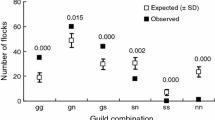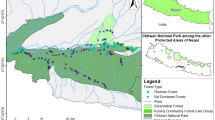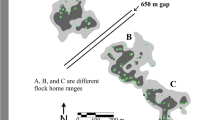Abstract
Bird species are hypothesized to join mixed-species flocks (flocks hereon) either for direct foraging or anti-predation-related benefits. In this study, conducted in a tropical evergreen forest in the Western Ghats of India, we used intra-flock association patterns to generate a community-wide assessment of flocking benefits for different species. We assumed that individuals needed to be physically proximate to particular heterospecific individuals within flocks to obtain any direct foraging benefit (flushed prey, kleptoparasitism, copying foraging locations). Alternatively, for anti-predation benefits, physical proximity to particular heterospecifics is not required, i.e. just being in the flock vicinity can suffice. Therefore, we used choice of locations within flocks to infer whether individual species are obtaining direct foraging or anti-predation benefits. A small subset of the bird community (5/29 species), composed of all members of the sallying guild, showed non-random physical proximity to heterospecifics within flocks. All preferred associates were from non-sallying guilds, suggesting that the sallying species were likely obtaining direct foraging benefits either in the form of flushed or kleptoparasitized prey. The majority of the species (24/29) chose locations randomly with respect to heterospecifics within flocks and, thus, were likely obtaining antipredation benefits. In summary, our study indicates that direct foraging benefits are important for only a small proportion of species in flocks and that predation is likely to be the main driver of flocking for most participants. Our findings apart, our study provides methodological advances that might be useful in understanding asymmetric interactions in social groups of single and multiple species.

Similar content being viewed by others
References
Aronson RB, Sanderson SL (1987) Benefits of heterospecific foraging by the Caribbean wrasse Halichoeres garnoti (Pisces: Labridae). Environ Biol Fish 18:303–308
Austin GT, Smith EL (1972) Winter foraging ecology of mixed insectivorous bird flocks in oak woodland in southern Arizona. Condor 74:17–24
Barnard CJ, Sibly RM (1981) Producers and scroungers: a general model and its application to captive flocks of house sparrows. Anim Behav 29:543–550
Beauchamp G (2004) Reduced flocking of birds on islands with relaxed predation. Proc R Soc Lond B 271:1039–1042
Berner TO, Grubb TC Jr (1985) An experimental analysis of mixed-species flocking in birds of deciduous woodland. Ecology 66:1229–1236
Boinsky S, Scott PE (1988) Association of birds with monkeys in Costa Rica. Biotropica 20:136–143
Buskirk WH (1976) Social systems in a tropical forest avifauna. Am Nat 110:293–310
Diamond JM (1981) Mixed-species foraging groups. Nature 292:408–409
Diamond JM (1987) Flocks of brown and black New Guinean birds: a bicoloured mixed-species foraging association. Emu 87:201–211
Dolby AS, Grubb TC Jr (1999) Functional roles in mixed-species flocks: a field manipulation. Auk 116:557–559
Dolby AS, Grubb TC Jr (2000) Social context affects risk taking by a satellite species in a mixed-species foraging group. Behav Ecol 11:110–114
Dunning JD Jr (2008) CRC handbook of avian body masses. CRC, Boca Raton
Foster WA, Treherne JE (1981) Evidence for the dilution effect in the selfish herd from fish predation on a marine insect. Nature 293:466–467
Goodale E, Kotagama SW (2005a) Testing the roles of species in mixed-species bird flocks of a Sri Lankan rain forest. J Trop Ecol 21:669–676
Goodale E, Kotagama SW (2005b) Alarm calling in Sri Lankan mixed-species bird flocks. Auk 122:108–120
Goodale E, Kotagama SW (2008) Response to conspecific and heterospecific alarm calls in mixed-species bird flocks of a Sri Lankan rainforest. Behav Ecol 19:887–894
Gotelli NJ, Entsminger GL (2001) EcoSim: null models software for ecology, version 1.0. http://garyentsminger.com/ecosim/index.htm
Greenberg R (2000) Birds of many feathers: the formation and structure of mixed-species flocks of forest birds. In: Boinski S, Gerber PA (eds) On the move: how and why animals travel in groups. The University of Chicago Press, Chicago, pp 521–559
Greig-Smith PW (1978) Imitative foraging in mixed-species flocks of Seychelles birds. Ibis 120:233–235
Greig-Smith PW (1981) The role of alarm responses in the formation of mixed-species flocks of heathland birds. Behav Ecol Sociobiol 8:7–10
Hamilton WD (1971) Geometry for the selfish herd. J Theor Biol 31:295–311
Herremans M, Herremans-Tonnoeyr D (1997) Social foraging in the Forktailed Drongo Dicrurus forficatus: beater effect or kleptoparasitism? Bird Behav 12:41–45
Hino T (1998) Mutualistic and commensal organization of avian mixed-species foraging flocks in a forest of western Madagascar. J Avian Biol 29:17–24
Hino T (2005) Resident males of small species dominate immigrants of large species in heterospecific, winter bird flocks. Ornithol Sci 4:89–94
Hutto RL (1994) The composition and social organization of mixed-species flocks in a tropical deciduous forest in western Mexico. Condor 96:105–118
King DI, Rappole JH (2001) Kleptoparasitism of laughingthrushes Garrulax by Greater racket-tailed drongos Dicrurus paradiseus in Myanmar. Forktail 17:121–122
Kotagama SW, Goodale E (2004) The composition and spatial organization of mixed-species flocks in a Sri Lankan rainforest. Forktail 20:63–70
Krause J, Ruxton GD (2002) Living in groups. Oxford University Press, Oxford
Krebs JR (1973) Social learning and the significance of mixed-species flocks of chickadees (Parus spp.). Can J Zool 51:1275–1288
Latta SC, Wunderle JM (1996) The composition and foraging ecology of mixed-species flocks in pine forests of Hispaniola. Condor 98:595–607
McLean IG (1984) Feeding association between fantails and saddlebacks: who benefits? New Zeal J Ecol 7:165–168
Morse DH (1970) Ecological aspects of some mixed-species foraging flocks of birds. Ecol Monogr 40:119–168
Morse DH (1977) Feeding behavior and predator avoidance in heterospecific groups. Bioscience 27:332–339
Morse DH (1980) Behavioural mechanisms in ecology. Harvard University Press, Cambridge
Munn CA (1986) Birds that cry ‘wolf’. Nature 391:143–145
Neill SRSJ, Cullen JM (1974) Experiments on whether schooling by their prey affects the hunting behavior of cephalopods and fish predators. J Zool 172:549–569
Oommen M, Shanker K (2009) Shrewd alliances: mixed foraging associations between treeshrews, greater racket-tailed drongos and sparrowhawks on Great Nicobar Island, India. Biol Lett 6:304–307
Peres CA (1992) Prey capture benefits in a mixed-species group of Amazonian tamarins Saguinus fuscicollis and S. mystax. Behav Ecol Sociobiol 31:339–347
Peres CA (1993) Anti-predator benefits in a mixed species group of Amazonian tamarins. Folia Primatol 61:61–76
Pomara LY, Cooper RJ, Petit LJ (2003) Mixed-species flocking and foraging behavior of four Neotropical warblers in Panamanian shade coffee fields and forests. Auk 120:1000–1012
Port M, Kappeler PM, Johnstone RA (2011) Communal defense of territories and the evolution of sociality. Am Nat 178:787–800
Powell GVN (1985) Sociobiology and adaptive significance of interspecific foraging flocks in the Neotropics. Ornithol Monogr 36:713–732
Pulliam HR (1973) On the advantages of flocking. J Theor Biol 38:419–422
Remsen JV Jr, Robinson SK (1990) A classification scheme for birds in terrestrial foraging habitats. Stud Avian Biol 13:144–160
Ridley AR, Raihani NJ (2007) Facultative response to a kleptoparasite by the cooperatively breeding pied babbler. Behav Ecol 18:324–330
Satischandra SHK, Kudavidanage EP, Kotagama SW, Goodale E (2007) The benefits of joining mixed-species flocks for greater racket-tailed drongos Dicrurus paradiseus. Forktail 23:145–148
Shelley EL, Tanaka M, Ratnathicam AR, Blumstein DT (2004) Can Lanchester’s laws help explain inter-specific dominance in birds? Condor 106:395–400
Sridhar H, Beauchamp G, Shanker K (2009) Why do birds participate in mixed-species foraging flocks? A large-scale synthesis. Anim Behav 78:337–347
Sridhar H, Srinivasan U, Askins RA, Canales-Delgadillo JC, Chen CC et al (2012) Positive relationships between association strength and phenotypic similarity structure the assembly of mixed-species bird flocks worldwide. Am Nat 180:777–790
Sridhar H, Jordán F, Shanker K (2013) Species importance in a heterospecific foraging association network. Oikos 122:1325–1334
Srinivasan U, Quader S (2012) To eat and not be eaten: modeling resources and safety in multi-species animal groups. PLoS ONE 7:e42071
Srinivasan U, Raza RH, Quader S (2010) The nuclear question: rethinking species importance in multi-species animal groups. J Anim Ecol 79:948–954
Stotz DF (1993) Geographic variation in species composition of mixed species flocks in lowland humid forests in Brazil. Pap Avul Zool 38:61–75
Styring AR, Ickes K (2001) Woodpecker participation in mixed species flocks in peninsular Malaysia. Wilson Bull 113:342–345
Sullivan KA (1984) Information exploitation by downy woodpeckers in mixed-species flocks. Behaviour 91:294–311
Swynnerton CFM (1915) Mixed bird-parties. Ibis 57:346–354
Székely T, Szép T, Juhász T (1989) Mixed species flocking of tits (Parus spp.): a field experiment. Oecologia 78:490–495
Thiollay J-M, Jullien M (1998) Flocking behaviour of foraging birds in a neotropical rain forest and the antipredator defence hypothesis. Ibis 140:382–394
Veena T, Lokesha R (1993) Association of drongos with myna flocks: are drongos benefited? J Biosci 18:111–119
Waite TA, Grubb TC Jr (1988) Copying of foraging locations in mixed-species flocks of temperate-deciduous woodland birds: an experimental study. Condor 90:132–140
Whitehead H (2008) Analyzing animal societies. The University of Chicago Press, Chicago
Acknowledgments
We thank the Ministry of Environment and Forests, Government of India and the International Foundation for Science (grant no. D/4910-1) for supporting this study and the Karnataka Forest Department for providing permits for field work. We thank Guy Beauchamp, Kavita Isvaran, and Maria Thaker for discussions regarding sampling design and analysis and comments on earlier manuscript drafts. HS thanks Prakash, Nagesh, Narayan, Chandrakant, and Sadanand for their help with field work.
Ethical standards
This study complies with the current laws of India, where the study was carried out.
Conflict of interest
The authors declare that they have no conflict of interest.
Author information
Authors and Affiliations
Corresponding author
Additional information
Communicated by P. A. Bednekoff
Electronic supplementary material
Below is the link to the electronic supplementary material.
Online Resource 1
(PDF 81.7 kb)
Online Resource 2
(PDF 109 kb)
Online Resource 3
(PDF 28.2 kb)
Online Resource 4
(PDF 22.7 kb)
Online Resource 5
(PDF 31.0 kb)
Online Resource 6
(PDF 39.2 kb)
Rights and permissions
About this article
Cite this article
Sridhar, H., Shanker, K. Using intra-flock association patterns to understand why birds participate in mixed-species foraging flocks in terrestrial habitats. Behav Ecol Sociobiol 68, 185–196 (2014). https://doi.org/10.1007/s00265-013-1633-3
Received:
Revised:
Accepted:
Published:
Issue Date:
DOI: https://doi.org/10.1007/s00265-013-1633-3




